Bathroom With Soaking Tub

Deep Soaking Tubs – Frequently Asked Questions
What is a deep soaking bathtub?
A deep soaking bathtub is a compact bath that is shorter but deeper than conventional baths. Essentially, it relies on depth rather than length for its capacity and comfort. The bather does not lie down with the head tilted forward, as in a traditional trough-shaped bath; he or she adopts a more upright, seated position.
Some manufacturers wrongly describe any comparatively deep bathtub as a deep soaking tub. This is misleading because in a long, deep bath, the bather does not maintain this comfortably seated position. Depth alone is not the defining characteristic.
A true deep soaking bathtub is defined by the bather's posture. A seated position takes strain off the neck and shoulders, while the depth of the water means that the weight of the body is well supported – enabling the user to feel almost weightless. The experience is significantly different from lying in a bath that is merely large. We believe the experience is far superior, and our many customer testimonials attest to this.
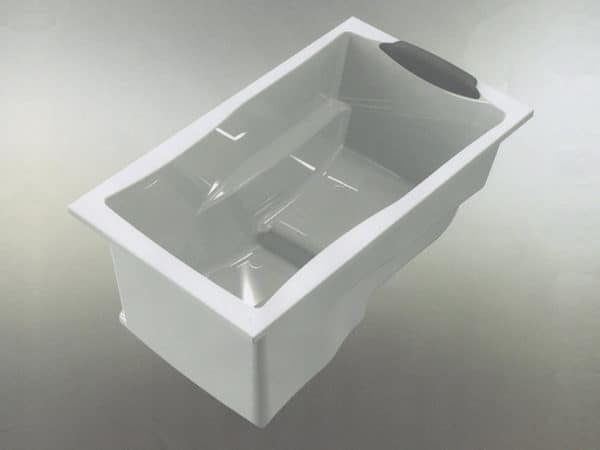
A 3D model of the Yasahiro deep soaking tub, showing the in-built seat, armrests and head-rest.
What is a Japanese style soaking tub?
The original Japanese soaking tub was the ofuro – typically a square-sided wooden bath, in which the bather sat upright. When, in 1991, we developed the Imersa – the world's first modern deep soaking tub – we took inspiration from this bath. We recognised that a more upright position could potentially be much more comfortable than the semi-prone position normally taken in a traditional Western bath. This is because a sitting bather feels much less strain on the neck and shoulders.
The Imersa was conceived and consciously designed as the Western World's first modern Japanese style soaking tub. It was compact and it promoted a comfortable, upright sitting posture, just as the ofuro had done. It became quickly popular, not least because of its space-saving design, which meant that it sat well in smaller contemporary bathrooms and en-suites.
Its success spawned many imitators and, today, opting for a Japanese style soaking tub is a steadily growing trend. Unfortunately, many of the products now on the market are of poor quality – made of cheap, flexible materials and featuring simple, bench-like seats that don't lend themselves to prolonged relaxation.
To preserve the value and reputation of the Japanese style design, we have continuously invested in research and new product development. This has resulted in an extensive range of Japanese style soaking tubs to suit varying needs and aesthetic tastes. The range even includes a two-seater soaking tub.
Importantly, our modern deep soaking tubs do not simply seek to replicate the wooden baths of Japanese history. They differ from the long-established ofuro in several respects – for example, because they are made with an in-built seat. Modern bathers – particularly those in the West – tend to find it far more comfortable to sit with their feet lower than the rest of the body, so a shallow seat is an invaluable component that makes a considerable difference to the bathing experience.
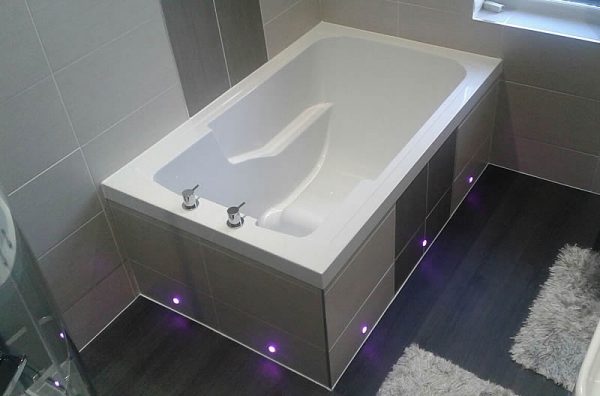
The Nirvana deep soaking tub (above) features a raised seat, a reclined back and armrests. It also includes integral footrests (not shown).
Another important difference is the choice of material. Our purpose-developed Ficore® composite is extremely durable, it can be produced in literally any colour, and it can reliably be used with added features such as hydrotherapy jets, chromotherapy lights and Bluetooth sound systems. It retains heat far more effectively than cast iron, fibreglass or acrylic and it is also supported by a 25 year guarantee.
What is the difference between a bathtub and a soaking tub?
A deep soaking tub is a specific and distinctive style of bathtub. Most ordinary baths tend to be long and low – essentially 'trough' shaped – whereas the deep soaking tub is deeper and often considerably shorter. The soaking tub is growing in popularity in modern homes because it saves space, water and energy, and because it is exceptionally comfortable.
There are, course, a number of other baths that are both large and deep. An example of a large, deep bath would be our own Pleasance Plus free standing bath, which takes some of its design inspirations from the Georgian 'slipper bath'. However, mere depth does not make a bath a deep soaking tub. For example, we would never categorise the Pleasance Plus (pictured below) as a deep soaking tub, despite its impressive 605mm depth.
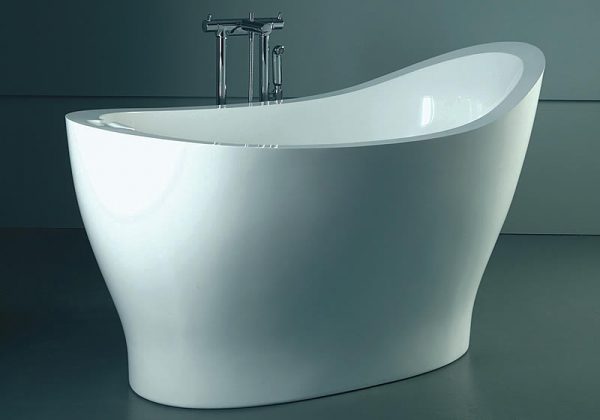
The Pleasance Plus (also by Cabuchon) is deep but it is NOT a deep soaking tub.
The principal differences that define a soaking tub are:
- A deep soaking tub is compact; it tends to be shorter but deeper than a conventional bath.
- A deep soaking tub typically has steep sided walls to create the maximum depth in the smallest possible 'footprint.'
- A deep soaking tub should have an integral seat to permit a comfortable sitting posture.
- In a deep soaking tub, the bather sits upright, shoulder deep in water, rather than lying back with his/her head bent forwards.
These key characteristics make for a comfortable, well supported bathing experience that leaves the neck and shoulders free of strain.
The compact dimensions of a deep soaking tub make it well suited for use in smaller bathrooms such as en-suites, loft conversions, older cottages and apart-hotels. Its size means that it can be used in more settings than a full-length bath, without compromising on comfort.
In other respects, most deep soaking tubs are similar to an ordinary bathtub. For example, they can be used with an overhead shower and bath/shower screen.
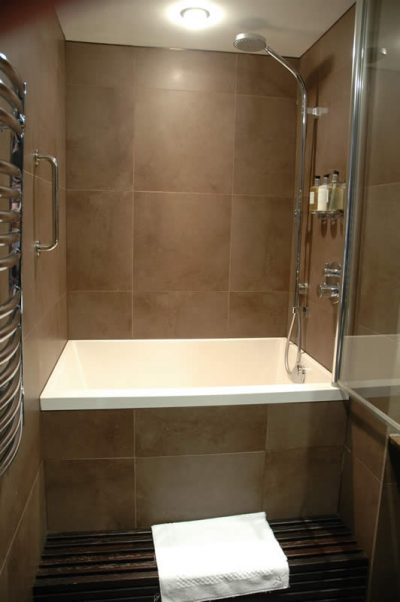
A Calyx deep soaking tub, installed in a boutique hotel. Note the overhead shower and screen, and the raised step for easier access.
What is a good water depth for a soaking tub?
The buoyancy felt while bathing in deep water is one reason why deep soaking tubs feel so comfortable. Consequently, one of the most useful rules when choosing a deep soaking tub is that the depth of water should be sufficient to cover the bather's chest while he or she is seated. As a rough guide, a soaking tub should have a minimum depth of approximately 600mm / 23¾″. (Our deep soaking tubs range in depth from 600mm to 715mm.)
However, different people come in different shapes and sizes, so in practice, there is no one fixed depth that defines whether or not a deep soaking tub is 'good' or 'effective'.
When choosing a soaking tub, an important consideration is versatility. Within a family, for example, there may be adults and children of different heights. Clearly, a soaking tub can be partially filled to accommodate a smaller bather, or filled more deeply for taller adults. We have known couples who bought our soaking tubs who were of very different heights. In some cases, our deep soaking tub customers have been over 6'7″ tall, yet they have all found our baths comfortable and accommodating. This is because our seats and foot wells are designed to allow users to slide either forwards or back. Sliding forwards permits a more reclined bathing position while sliding back puts the bather in a more upright position. In this way, different bathers can enjoy full, chest-deep immersion, just by changing their seating position.
In many respects, posture is a more important factor than depth. A soaking tub should enable the bather to sit comfortably upright, well supported by the water. A properly contoured seat and backrest are essential for a truly comfortable soak. Some models of soaking tubs also have armrests and footrests to further support the body and to enable easy re-positioning.
How much water does a soaking tub take to fill?
Deep soaking tubs generally take less water to fill than conventional baths. Although they are deeper than ordinary baths, they are also usually much shorter. If they also feature an in-built seat (which takes up some of the internal volume) then the combined effect is a bath that delivers significant savings on water – and the energy required to heat it.
Our deep soaking tubs come in a variety of sizes, the largest being the Xanadu two-person soaking tub. Consequently, water volumes vary, but a single-person soaking tub should certainly deliver savings. Some examples from our range are listed below:
- Calyx 1230: 177 Litres (39 Imperial gallons or 47 US gallons.)
- Imersa (larger model): 200 Litres (44 Imperial Gallons, 53 US Gallons.)
- Nirvana: 214 Litres (47 Imperial gallons, 57 US gallons.)
By way of comparison, our Talisien free standing bath requires 390 litres to fill (equivalent to 72 Imperial gallons or 86 US gallons.)
Do soaking tubs have jets?
Deep soaking tubs do not have to be supplied with hydrotherapy jets. A bespoke hydrotherapy system is an optional extra on all Cabuchon deep soaking tubs. Many customers choose the bath alone. However, it is certainly true that hydrotherapy systems and deep soaking tubs are exceptionally well suited. The bathing posture means that the user is supported in a relaxed position that makes him/her very receptive to the therapeutic effects of the water jets, while the baths' small dimensions mean that the jets themselves will always be very close to the body. This means that heat transfers effectively and the force of the jets is not dissipated through a relatively large volume of water.
For more details, please see our blog post: deep soaking tubs and hydrotherapy: convergent technologies.
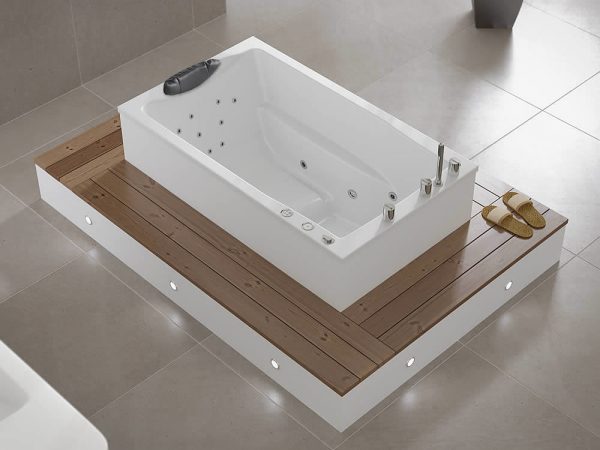
The Yasahiro deep soaking tub, fitted with hydrotherapy jets.
For more details, please download our free PDF Guide to Choosing a Deep Soaking Tub.
Related Posts
Source: https://www.cabuchon.com/deep-soaking-tubs-frequently-asked-questions/








Tidak ada komentar:
Posting Komentar